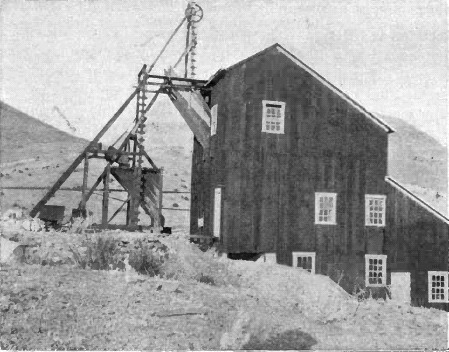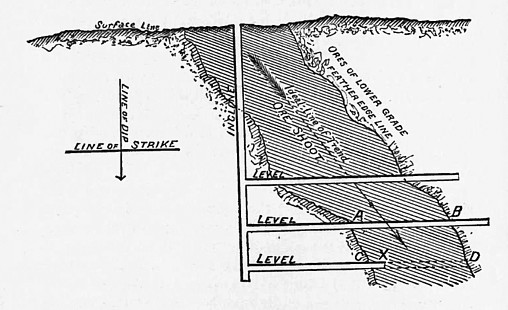Gold: A test known as Darton's is believed to be a valuable means of detecting minute quantities of gold in rocks, ore tailings, etc. "Small parts are chipped from all the sides of a mass of rock, amounting in all to about | ounce. This is powdered in a steel mortar and well mixed. About half is placed in a capacious test tube, and then the tube is partly filled with a solution made by dissolving 20 gr. of iodine and 30 gr. of iodide of potassium, in about 10 ounces water. The mixture thus formed is shaken and warmed. After all particles have subsided, dip a piece of fine White filter paper in it; allow it to remain for a moment ; then let it drain, and dry it over the spirit lamp. It is next placed upon a piece of platinum foil held in a pincers, and heated to redness over the flame. The paper is speedily consumed; and after again heating to burn off all carbon, it is allowed to cool and is then examined. If at all purple, gold is present in the ore, and the relative amount may be approximately deduced. This method takes little time, and is trustworthy."
Copper: Copper is a very easy mineral to test for. First crush the ore and dissolve it in nitric acid by heating. Then dilute with some water, and add ammonia. The solution should turn dark blue. The carbonate ores of copper do not extend deep in the mine. Their places are taken by copper pyrites. Sulfide ores are usually difficult to treat, and when they are to be tested it is better to roast them before trying the tests for color. Test for copper may also be made as follows: The sample must be pulverized. Take an ounce of the powder, and place in a porcelain cup. Add forty drops of nitric acid, twenty drops of sulfuric acid and twelve drops of hydrochloric acid. Boil over the spirit lamp until white fumes arise. When cool, mix with a little water. Filter and add a nail or two to the liquid. The copper will be precipitated, and may be gathered up and weighed. The amount of copper in the sample multiplied by 32,000 will be the copper in a ton of the ore. Should copper be suspected, roast the powdered ore and mix with an equal quantity of salt and candle grease or other fat; then cast into the fire, and the characteristic flame of copper first blue and then green will appear. This test is better made at night.
Mercury:. Cinnabar, the common ore of mercury, is a sulfide. Scratch it with a knife, and the streak will be bright crimson. Dissolve the ore in nitric acid, add a solution of caustic potash, and you have a yellow precipitate. A very pretty test is to place the ore pulverized in a glass tube with some chloride of lime; close the top of the tube, and place a smaller one therein, so bent that it will pass into a basin of water; heat the bottom of the tube containing the ore and lime, keeping the upper part and the small tube cold with wet rags, and you will have a deposit of quicksilver in the basin.
Silver: silver ores may be detected by dissolving a small quantity in a test tube with a few drops of nitric acid. Boil until all the red fumes disappear. Let the solution cool, and add a little water. Filter the whole, and add a few drops of muriatic acid, which will precipitate the white chloride of silver. Dissolve this precipitate with ammonia; then add nitric acid once more. Exposed to the light, the precipitate soon shows a violet tint. Pure silver is the brightest of metals, of a brilliant white hue, with rich luster. To detect chloride of silver in a pulp, rub harshly with a clean, bright and wet copper cartridge or coin, and if there be silver in the pulp the copper will be coated with it. Graphite will also whiten copper, but the film is easily rubbed off.
Nickel: Nickel may be determined as follows: A little of the powdered ore taken up on the point of a penknife, and dissolved in a mixture of ten drops of nitric and five drops of muriatic acid, should be boiled over a lamp for a few minutes, and ten or twelve drops of water added. A small quantity of ferro-cyanide of potash will throw down a whitish-green precipitate, indicating nickel.
Platinum: Platinum is a most refractory metal to treat, as it must be boiled for at least two hours in the mixture of muriatic and nitric acid, known as aqua regia. A small amount of alcohol is to be added to the solution, and the latter filtered. The platinum is precipitated with ammonia chloride.
Manganese: Manganese may be proved as follows: A few grains of powdered ore are placed in a test-tube, with three or four drops of sulfuric acid. Two or three grains of granulated lead or litharge being dropped in, the color will become pink should manganese be in the ore. A preliminary examination of a mineral may be made with a pocket lens and a penknife. With the first, any conspicuous constituents may be recognized, while a scratch with the point of the latter will give an idea as to the softness or hardness of the mineral. Should much quartz (silica) be present, a sharp blow with the steel will cause sparks. The next test should be with some ore powdered and held over a spirit flame. A drop or two of water and a drop of sulpho-cyanide of potash will reveal iron, should such be present, by a deep red coloration. To another portion add one drop of hydrochloric acid, and a dense, curdy precipitate will indicate silver, if there be any. Added to the same original nitric acid solution, several drops of ammonia water would detect copper by a blue color.
Antimony, tin, aluminum, zinc, cobalt and nickel, uranium and titanium are best shown by the blowpipe. Carbonates, that is those minerals that contain carbon and oxygen in addition to the metal, effervesce when brought into contact with hydrochloric acid. Some sandstones have a small amount of lime carbonate, and must be tried under the lens, as the bubbles are microscopic. These tests are extremely useful, but by no means infallible, owing to so few ores being pure. When the explorer wishes to know all the constituents of the ore he has found, he must analyze it. An analysis gives every substance in the ore. Such examinations may be either by the "dry" or "wet" methods, though usually the term "analysis" is restricted to the latter, and "fire assay" is used to describe the former. The wet assay for silver, lead or mercury is effected as follows:
Drop a little powdered ore in a test tube; add nitric acid; dilute with ^ water; warm gently over the spirit lamp. It may dissolve or it may not. In the latter case, add four times as much hydrochloric acid. Should all these attempts fail, a fresh sample must be taken, and equal parts of sodium carbonate and potassium carbonate added, and the whole strongly heated in a platinum crucible. The contents, after cooling, is dissolved in dilute nitric acid. In any case the assay will now be dissolved, and will be in the solution. Filter. Pour ten drops into a test tube; add three or four drops of hydrochloric acid. A precipitate appears. It may be silver, lead or mercury. - If silver, it grows dark violet after exposure to sunlight, or 30 or 40 drops of ammonia dissolves it in a few moments. Should it not dissolve, it is lead or mercury. Test for lead by filtering, and heating some of the precipitate on charcoal before the blow-pipe. A bead and yellow incrustation indicate lead. Should none of these things happen, then the metal is mercury. Filter; place in glass tubes; heat gently, and a mirror of quicksilver will appear on the sides of the glass. This is as far as the prospector, without the various reagents and chemicals that the analyst has always at hand, will be able to go. More complex treatment must be reserved until a return to civilization.
Continue on to:
Identifying Ores of Silver, Copper and Lead
Return To:
Gold and Silver Prospecting Basics


